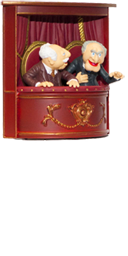I have question for you diet gurus out there.
I heard people in the past talk about eating different types of carbs/fats etc.. (things like complex carbs, etc..)
If I am dieting to lose weight, does it matter what type of calories i consume? let's say i'm burning 2500cal/day and i'm eating 2000 calories. I still have a deficit of 500 cals. Does it matter if it's pure carb/fat or whatever... Obviously healthy wise a certain portion of it has to meet daily requirements of nutrients, but beyond that does it really matter?
Oh and while we are on the topic what are complex carbs anyway?
Dieting Tips
26 posts
• Page 1 of 2 • 1, 2
Re: Dieting Tips
I'm not a dieting guru, but here's how I understand it.
It seems like it isn't merely a matter of calories in / calories out. The type of calories consumed (and when they're consumed) does play a role.
Foods with a high glycemic index (simple sugars, ie. white bread, candy) are digested and converted into energy quickly. If you're not doing something to burn them off immediately (like running a marathon, or playing hockey), your body converts them into fat. Because they are digested so quickly, you end up getting hungry sooner. Your body raises your insulin level to counter the sudden effects of the high levels of sugars in your body. If you do this too often, your body eventually gives up trying to counter the effects of the sugar. This is known as diabetes.
Foods with a low glycemic index (complex carbs, ie. whole wheat bread, oatmeal) are digested more slowly providing a more even 'distribution' of energy throughout your day and leaving you feeling fuller longer. Because the energy distribution is more level (versus causing a spike in blood-sugars), your body does not need to counter the effects by creating insulin.
Avoiding eating fats is not a good idea either. The body needs fat to live. If you're starving it of fat, then whatever fat you do consume, your body hoards and stores... even if you have a lot stored already.
There's a lot about the body that we don't understand though, and I expect more flip-flopping from doctors/dieticians on what constitutes a healthy diet in the future.
*edit: I mixed up high GI and low GI. I corrected my post.
It seems like it isn't merely a matter of calories in / calories out. The type of calories consumed (and when they're consumed) does play a role.
Foods with a high glycemic index (simple sugars, ie. white bread, candy) are digested and converted into energy quickly. If you're not doing something to burn them off immediately (like running a marathon, or playing hockey), your body converts them into fat. Because they are digested so quickly, you end up getting hungry sooner. Your body raises your insulin level to counter the sudden effects of the high levels of sugars in your body. If you do this too often, your body eventually gives up trying to counter the effects of the sugar. This is known as diabetes.
Foods with a low glycemic index (complex carbs, ie. whole wheat bread, oatmeal) are digested more slowly providing a more even 'distribution' of energy throughout your day and leaving you feeling fuller longer. Because the energy distribution is more level (versus causing a spike in blood-sugars), your body does not need to counter the effects by creating insulin.
Avoiding eating fats is not a good idea either. The body needs fat to live. If you're starving it of fat, then whatever fat you do consume, your body hoards and stores... even if you have a lot stored already.
There's a lot about the body that we don't understand though, and I expect more flip-flopping from doctors/dieticians on what constitutes a healthy diet in the future.
*edit: I mixed up high GI and low GI. I corrected my post.
Inhaled nun sap
punish anal end
punish anal end
-

se7entse7en - Kerry Fraser, Head Zebra
- Posts: 2004
- Joined: Tue Nov 03, 2009 11:57 am
Re: Dieting Tips
So would fruits be under the simple sugars category, or complex?
-

geForce - My name is Nathan and I have a problem.
- Posts: 7211
- Joined: Tue Nov 03, 2009 2:10 pm
Re: Dieting Tips
the carbs contained in fruits are simple sugars... but their Glycemic index can varry.
Some have a Low GI because of the fiber and other crap you eat with so its not neccessarily that bad. Kinda like if you ate a slab of fat, it would be fatty, but if you ate that slab of fat mixed in with massive slab of lean beef, then what you ate wouldnt be considered that fatty.
IMHO, from personal experience unless you're planning on doing a bodybuilding competition where you want to be sub 10% body fat it doesn't really matter.
Calories in vs Calories out is the biggest factor in a diet.
Complex carbs and food that fill you up without having too many calories help mostly in moderating your hunger.
Some have a Low GI because of the fiber and other crap you eat with so its not neccessarily that bad. Kinda like if you ate a slab of fat, it would be fatty, but if you ate that slab of fat mixed in with massive slab of lean beef, then what you ate wouldnt be considered that fatty.
IMHO, from personal experience unless you're planning on doing a bodybuilding competition where you want to be sub 10% body fat it doesn't really matter.
Calories in vs Calories out is the biggest factor in a diet.
Complex carbs and food that fill you up without having too many calories help mostly in moderating your hunger.

-

supersuk - I have become a real hockey player, on the D line now
- Posts: 1009
- Joined: Tue Nov 17, 2009 2:05 am
Re: Dieting Tips
When looking at weight loss, it is helpful to class foods into two categories: high-concentration foods and low-concentration foods. Meat, dairy foods, grains, and most junk foods are highly concentrated in calories, whereas fruit and vegetables are high in water content and fiber, making them far lower in calories. In other words, you don’t have to eat less, just eat more from the low-concentration food categories.
But what about all that fruit sugar? How does that fit into that now famous glycemic index diet which involves eating foods low on the index? Doing this helps prevent a spike in blood sugar, which we now know produces body fat. See if you can answer this question: what enters more gradually into the bloodstream, a complex carbohydrate or fruit? Most of us would answer confidently that fruit enters the bloodstream more quickly because it is a simple sugar, whereas complex carbohydrates like bread, potatoes, rice and pasta are gradually digested and broken down into glucose. But this is a misconception.
According to the blood glucose response table given as a guide to diabetics, bread, beans, white potatoes, and brown rice all break down to glucose in the bloodstream more quickly than most fruit. White sugar has a less dramatic shock to blood sugar levels than whole wheat bread!
Fructose, the sugar commonly found in all fruit, is the gentlest sugar to enter the bloodstream, requiring the least amount of insulin.
Complex carbohydrates melt in your mouth into simple sugars because of the digestive enzyme alpha-amylase that is present in the saliva. Chewing a slice of whole wheat bread will transform up to 50% of the starch into glucose before it even hits the stomach. Fruit is a better source of fuel than bread because of its ability to sustain energy without overtaxing the pancreas for insulin production. Fructose does not need insulin to break down as it is slowly absorbed through the lower intestinal wall.
All starch is composed of long chains of sugar molecules. Through digestion, these chains are broken down into simple sugars. Fruit, bread, potatoes, rice, and beans are all reduced to glucose. Of these foods, fruit requires the least digestion to supply the body’s need for glucose fuel.
But what about all that fruit sugar? How does that fit into that now famous glycemic index diet which involves eating foods low on the index? Doing this helps prevent a spike in blood sugar, which we now know produces body fat. See if you can answer this question: what enters more gradually into the bloodstream, a complex carbohydrate or fruit? Most of us would answer confidently that fruit enters the bloodstream more quickly because it is a simple sugar, whereas complex carbohydrates like bread, potatoes, rice and pasta are gradually digested and broken down into glucose. But this is a misconception.
According to the blood glucose response table given as a guide to diabetics, bread, beans, white potatoes, and brown rice all break down to glucose in the bloodstream more quickly than most fruit. White sugar has a less dramatic shock to blood sugar levels than whole wheat bread!
Fructose, the sugar commonly found in all fruit, is the gentlest sugar to enter the bloodstream, requiring the least amount of insulin.
Complex carbohydrates melt in your mouth into simple sugars because of the digestive enzyme alpha-amylase that is present in the saliva. Chewing a slice of whole wheat bread will transform up to 50% of the starch into glucose before it even hits the stomach. Fruit is a better source of fuel than bread because of its ability to sustain energy without overtaxing the pancreas for insulin production. Fructose does not need insulin to break down as it is slowly absorbed through the lower intestinal wall.
All starch is composed of long chains of sugar molecules. Through digestion, these chains are broken down into simple sugars. Fruit, bread, potatoes, rice, and beans are all reduced to glucose. Of these foods, fruit requires the least digestion to supply the body’s need for glucose fuel.
-

jeSteR - Reg Dunlop
- Posts: 2432
- Joined: Tue Nov 03, 2009 10:59 am
- Location: Um... right here.
Re: Dieting Tips
That's good info on sugars... it's a pretty confusing subject for sure.
How about the topic on fats then. Keian mentioned it a bit, but the explanation wasn't too clear... but it was probably more of a analogy for the sugar topic more than anything.
But yeah... I'm also confused about the saturated/unsaturated fat, and what's good and bad fat to eat?
How about the topic on fats then. Keian mentioned it a bit, but the explanation wasn't too clear... but it was probably more of a analogy for the sugar topic more than anything.
But yeah... I'm also confused about the saturated/unsaturated fat, and what's good and bad fat to eat?
-

geForce - My name is Nathan and I have a problem.
- Posts: 7211
- Joined: Tue Nov 03, 2009 2:10 pm
Re: Dieting Tips
Oh and aside from what types of foods to eat... I heard that quantity and timing of food intake is important too.
I heard that instead of 3 big meals per day, eating 6 small meals throughout the day is better.
Also, time it so you eat at least 2-3 hours before sleeping. Sleeping immediately after a meal is bad for digestion and leads to weight gain.
I have also read some pretty complicated eating plans for people who work out too. Like, eating high protein meals after working out, or eating high carb meals before a strenuous exercise. If you're looking for fat loss, then working out in the morning before breakfast will make your body burn energy from your fat reserves instead of from the food you ate immediately prior to working out.
It all seemed pretty complicated to me... seems pretty depressing to have to eat on such a strict schedule.
I heard that instead of 3 big meals per day, eating 6 small meals throughout the day is better.
Also, time it so you eat at least 2-3 hours before sleeping. Sleeping immediately after a meal is bad for digestion and leads to weight gain.
I have also read some pretty complicated eating plans for people who work out too. Like, eating high protein meals after working out, or eating high carb meals before a strenuous exercise. If you're looking for fat loss, then working out in the morning before breakfast will make your body burn energy from your fat reserves instead of from the food you ate immediately prior to working out.
It all seemed pretty complicated to me... seems pretty depressing to have to eat on such a strict schedule.
-

geForce - My name is Nathan and I have a problem.
- Posts: 7211
- Joined: Tue Nov 03, 2009 2:10 pm
-

supersuk - I have become a real hockey player, on the D line now
- Posts: 1009
- Joined: Tue Nov 17, 2009 2:05 am
Re: Dieting Tips
Inhaled nun sap
punish anal end
punish anal end
-

se7entse7en - Kerry Fraser, Head Zebra
- Posts: 2004
- Joined: Tue Nov 03, 2009 11:57 am
Re: Dieting Tips
i can't really give any scientific backing on my opinion on the subject of when to eat...
but i have found a few things that i prefer from personal preference.
i typically do not eat within 2 hours before i work out or play hockey (used to). mostly because when i'm in the gym or on the ice the last thing i want to deal with is a stomach cramp or indigestion. I want my focus to be on the actual physical activity rather than any side affect to what i ate last. If i do have to have something b/c i haven't had anything food yet, i try to keep to something really light, like fruits. the other thing i noticed is that i find if i excercise on a completely empty stomach, i don't last very long... fatigue and light headness usually sets in before i actually get in a good amount of excercise, if i don't have something substantial at least 4 hours prior to exercising.
i think the small multiple meals has to do something with improving metabolism throughout your day...
and i think the eating before sleep thing is that since your activity level is at its lowest point in the day, calories consumed are most likely converted to fat. which becomes more difficult to burn than any other calorie source in your body. but that's just what i've heard so i don't really know.
but i have found a few things that i prefer from personal preference.
i typically do not eat within 2 hours before i work out or play hockey (used to). mostly because when i'm in the gym or on the ice the last thing i want to deal with is a stomach cramp or indigestion. I want my focus to be on the actual physical activity rather than any side affect to what i ate last. If i do have to have something b/c i haven't had anything food yet, i try to keep to something really light, like fruits. the other thing i noticed is that i find if i excercise on a completely empty stomach, i don't last very long... fatigue and light headness usually sets in before i actually get in a good amount of excercise, if i don't have something substantial at least 4 hours prior to exercising.
i think the small multiple meals has to do something with improving metabolism throughout your day...
and i think the eating before sleep thing is that since your activity level is at its lowest point in the day, calories consumed are most likely converted to fat. which becomes more difficult to burn than any other calorie source in your body. but that's just what i've heard so i don't really know.
-

joel - 7 Time Norris Trophy Winner
- Posts: 2753
- Joined: Tue Nov 03, 2009 12:08 pm
Re: Dieting Tips
Wow Shaun, you say you're not an expert, but you sure sound like one! 
That's great info!
That's great info!
-

geForce - My name is Nathan and I have a problem.
- Posts: 7211
- Joined: Tue Nov 03, 2009 2:10 pm
Re: Dieting Tips
eating before sleeping also makes for bad sleep.
or at least the baby doctor told us that.
or at least the baby doctor told us that.

-

nature boy - 浪費時間
- Posts: 15107
- Joined: Sun Nov 15, 2009 7:35 pm
- Location: vansurcouvatoonaby
Re: Dieting Tips
Homer Simpson: "hehe, it's 'learn-NED', Pepsi... it's pronounced 'learn-NED' "
-

geForce - My name is Nathan and I have a problem.
- Posts: 7211
- Joined: Tue Nov 03, 2009 2:10 pm
Re: Dieting Tips
After experimenting with certain foods over the years I've found that swiss chard seems to always give me a boost on my runs.
I read this article the other day:
http://www.precisionnutrition.com/beets-and-beetroots
FYI, swiss chard is beet greens.
Eat up before your next big game.
I read this article the other day:
http://www.precisionnutrition.com/beets-and-beetroots
FYI, swiss chard is beet greens.
Eat up before your next big game.
Inhaled nun sap
punish anal end
punish anal end
-

se7entse7en - Kerry Fraser, Head Zebra
- Posts: 2004
- Joined: Tue Nov 03, 2009 11:57 am
26 posts
• Page 1 of 2 • 1, 2
Who is online
Users browsing this forum: No registered users and 1 guest
